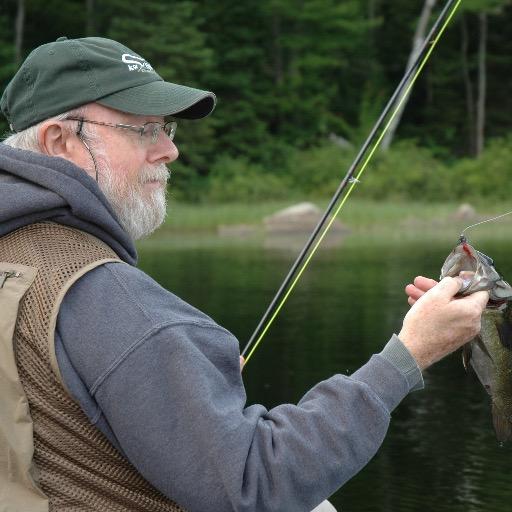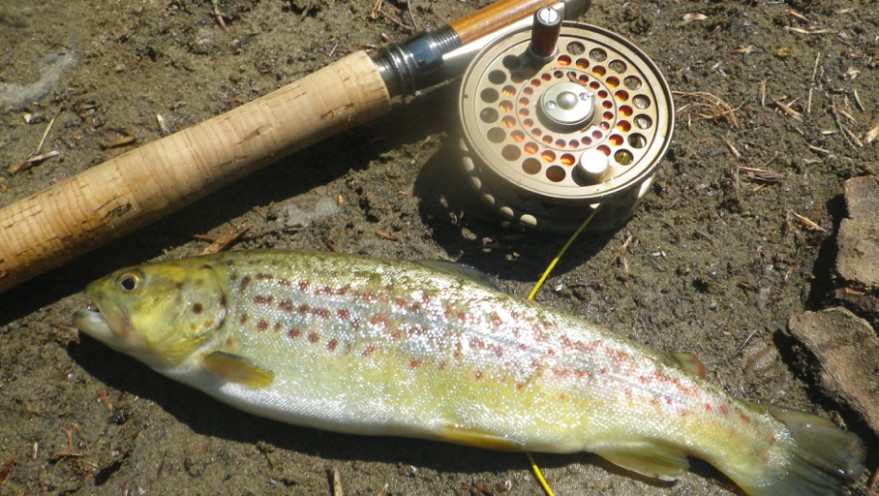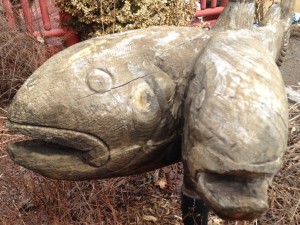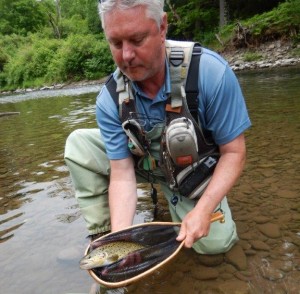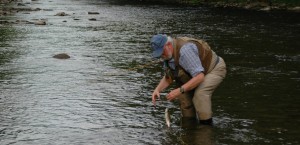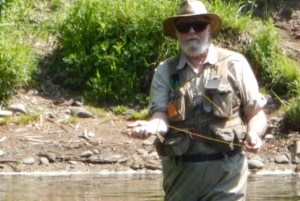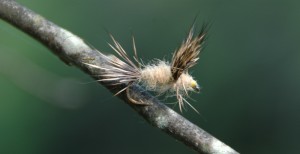The river flowed both ways. The current moved from north to south, but the wind usually came from the south, rippling the bronze-green water in the opposite direction.
— Margaret Laurence
Like the river in Margaret Laurence’s 1974 novel The Diviners, the trout rivers of Roscoe, New York, flow both ways — at least symbolically. This ‘impossible contradiction, made apparent and possible’ is the result of the convergence of past and present, then and now, in the cradle of American fly fishing.
The metaphor of rivers flowing both ways is embodied in the legendary Junction Pool where Willowemoc Creek flows into the Beaverkill River in the heart of Roscoe, otherwise known as Trout Town USA.
The notion of rivers flowing in opposite directions has even given rise to the tale of two-headed trout.
The website of the Roscoe Beer Company — which craft-brews Trout Town Brown Ale, Rainbow Red Ale and Brook Trout Amber Ale among other beers — explains the tale this way:
‘Legend has it that a migrating trout paused at the junction of the Beaverkill River and Willowemoc Creek to decide which route it should take. After first inspecting one river, and then the other, both [were] so appealing . . . the trout could not decide which river to live in. The decision proved so difficult that [it] eventually settled into the Junction Pool and sprouted a second head so it could sit facing up both rivers and would not have to choose one over the other.’
Peter Kaminsky, author of The Moon Pulled Up an Acre of Bass and The Fly Fisherman’s Guide to the Meaning of Life, straddles past and present, then and now, in his account of Opening Day festivities in a 2 April 1995 New York Times outdoor column:
‘In the observation of a half-century tradition, New York fly-fisherfolk gathered Friday night near the Junction Pool of the Beaverkill for the annual Two-Headed Trout dinner. Begun in the 1940’s by former New York Timesman Red Smith, the original group of diners included flyfishing pioneer Lee Wulff and A. J. McClane . . . perhaps the greatest American angling author of all time — if you don’t count Ernest Hemingway. Over the years the dinner party grew, taking over all of the tables in the Antrim Inn . . . which went out of business a few years ago (and is currently being refurbished).
‘The party and the trout have since moved to the nearby Rockland House and yes, the trout does have two heads, but savvy anglers have long suspected a taxidermist’s subterfuge.
‘It must have been the roast beef or maybe just the excitement of a new season, but at 3:30 am, I was sitting up in bed and staring out the window at a clear sky full of stars as bright as Christmas lights. In my state of half slumber, I heard the whistle and rumble of a phantom freight train. There are no trains to the Beaverkill anymore. There hasn’t been one for years, but my sleepy mind was full of stories of Lee Wulff and Ray Bergman (author of the classic Trout) who used to take the train to the Beaverkill in the days before the highway.
‘I dozed on and off (mostly off) until 5:30, at which point I left my motel room and walked down to the Junction Pool. There were a few fishermen ahead of me. The day was clear but cold. The banks filled up with anglers, 30 of them by 6:05. The trout were surrounded by anglers who threw feathers, metal and bait at the Beaverkill browns. We left the pool before the first fish was caught.’
Past and present, then and now, converged when I made my first extended visit to Roscoe for eight days of fly fishing spanning the last days of May and first days of June. It wasn’t more than a couple of days before my thoughts turned to Sir Izaak’s The Compleat Angler, which is subtitled The Contemplative Man’s Recreation. Since its publication in 1655, the fraternity of anglers throughout the world has celebrated fishing as a contemplative recreational sport. This holds especially true for fly angling.
But contemplation is a perilous condition for an angler, especially one who casts fur & feather at wary trout. The reflective angler with fly rod in hand who is lost in the contours of his own mind is susceptible to missing a strike. After all, hooking a fish requires concentration and focus; not dreamy mental wanderings like one of Wordworth’s lonely clouds.
I was reminded of this piscatorial fact while fishing a run on Willowemoc Creek, outside of Roscoe. As I was thinking long slow thoughts about writing an account of my first sustained trip to the cradle of American fly fishing, a good-sized trout struck my fly. Distracted by the poetry of my thoughts, I failed to set the hook. It was a case of hit and run.
I was in the Catskills on ‘the banks of the great tradition’ (the phrase comes from Frank Mele’s wonderful memoir Small in the Eye of a River) with my fly fishing buddy Dan Kennaley and his brother Martin, a muskie warrior from Pigeon Lake in Ontario’s Kawartha area who occasionally trades his big stick and large lures for willowy rod and small flies. One of the most memorable events of the trip was watching Martin land a 15-inch brook trout on a rod with a broken tip and with an unknown fly he had tied at home.
I had failed to catch the rising brookie after more than an hour of diligent frustration at dusk on the Upper Beaverkill. I felt like the angler M.R. Montgomery describes in Many Rivers to Cross when he remarks: ‘There is nothing like being able to cast over and over and yet over again to the same disinterested fish to convince you that some form of intelligence is arrayed against you.’
Not to be deterred, I offered the pool to Martin who caught the lovely speck after a few casts. Such are the unpredictable wiles of finicky trout. Over beers back at camp, Dan and I christened the fly ‘the Martykill.’
A few days later I’m at home and sitting at my desk as thoughts return to what I was reflecting on while fishing the Willowemoc. What follows are the fleeting thoughts that floated to the surface of consciousness on that glorious day on one of fly angling’s hallowed waters.
Although fly fishing predates organized baseball, basketball, football and hockey, it’s the preeminent ‘postmodern’ recreational sport in North America. And nowhere is this more evident than in the Catskills. Although I use the term ‘postmodern’ loosely and non-academically, I apply it to fly fishing in recognition of how the sport merges tradition and innovation, organic and manufactured, natural and artificial, memory and expectation.
With the incessant dissonance of cars and transport trucks racing along Hwy 17 — snaking its way through some of the world’s most famous trout water — anglers wade in the same tranquil rivers and streams in which the legends (Gordon, Hewitt, LaBranche, Rhead, Cross, Atherton, Taintor Foote, Hendrickson, Dette, Darbee, Steenrod, Jennings, Bergman, McClane, Ovington, Wulff, Flick, Schwiebert, Grey Hackle and Gingrich) once waded. It’s akin to hitting baseballs in Yankee Stadium or shooting pucks in Maple Leaf Gardens.
Sharing water with friendly ghosts, who whisper encouragement if you have ears to hear, casts a spell of recognition and delight. Companionship with those who have fished these sacred waters before heightens and enriches an angler’s experience of what William Blake called the Eternal Now.
Like a river flowing both ways, I straddle past and present, then and now, by immersing myself in fly fishing’s history and tradition through the choices I make as an angler. I cast a Sweetgrass split-cane fly rod. Based in Twin Bridges, Montana, Sweetgrass is a contemporary company that carries forward the dedication to quality exemplified by such legendary New England companies as Leonard and Payne and Garrison.
Sweetgrass also connects me to fly fishing’s rich literary heritage. A major reason I was attracted to Sweetgrass in the first place was because of Jerry Kustich, one of the company’s four ‘Booboy’ founders. Kustich was not only a fine rod builder until his retirement, he’s one of the best contemporary fly angling writers whose books include A Wisp in the Wind, At the River’s Edge and Around the Next Bend among others. As an armchair angler who occasionally sets pen to paper (actually it’s pounding away on a computer keyboard) I remain inspired by Jerry’s example.
Similarly, many of the flies I cast are tied by Dan, my angling mentor. He’s a gifted tier. His comparaduns, while based on dressings designed by Al Caucci and introduced in his seminal book Hatches (co-authored with Bob Nastasi), hearken back to the traditional haystack dry fly of earlier times. In contrast to the sleek anorexic comparaduns that populate the bins in fly shops, Dan’s comparaduns are chunkier, juicier — appealing to the meat-and-potato appetites of rapacious trout.
The weather was unseasonably warm when we visited the Catskills. There was some rain but our trip was defined by blazing sun. Dan caught the most fish, a higher proportion of big fish and was most consistent in his success, while Martin and I caught fewer fish and were occasionally skunked.
Here’s a rundown of the highs and lows of my fishing exploits:
∙ All but one fish caught were brown trout.
∙ Didn’t catch a fish on any of the recommended flies I purchased at local fly shops.
∙ One notable brookie of about 10 inches wiggled to freedom on a run in the Willowemoc before I could snap a photo. I was using an elk-hair caddis. It was the last fish I landed before returning home.
∙ Best outing was casting Dan’s Gray Fox comparadun into a curvaceous pool on the Willowemoc. I caught a half dozen brownies, three of which were in the 9 to 12-inch range.
∙ Caught an 11 to 13-inch brownie (the biggest fish of the trip) with Dan’s Gray Fox comparadun on the upper Beaverkill. It slipped through my hands before Dan could get a grip-and-grin photo; however, he managed to get a couple of shots of me playing the fish. Turns out documenting a landed fish can be as difficult as catching the fish in the first place.
∙ The most frustrating fishing occurred in the evenings on the Cairns and Cemetery pools on the main Beaverkill as we waited on Green Drake (commonly called Coffin Fly) spinner falls. One night I thought I had caught a big trout but it turned out to be a feisty smallmouth bass.
Anglers obviously fish to catch fish but there is more to experiencing nature than what swims below the surface of water. I saw numerous whitetail deer, a couple of porcupines, half a dozen wild turkeys, groundhogs, various birds including a pair of yellow-bellied sapsuckers, in addition to ducks and Canada geese. I shared water with working beavers and, most spectacular of all, witnessed a bald eagle flying at low altitude along the course of the Beaverkill in search of supper.
I’m keen to return to the Catskills and its ‘great rivers of angling history’ (from Mele’s Small in the Eye of a River). But I’m just as excited about visiting I’m just as excited about visiting the Adirondacks and perhaps even Vermont and New Hampshire (I’m a fan of W.D. Wetherell’s Vermont River, Upland Stream and One River More), not to mention Maine — places where fly fishing in North America established deep roots in the late 19th century. And then there’s Michigan’s Upper Peninsula, where Hemingway, Robert Traver and recently deceased Jim Harrison fished, not to mention Montana. All places I hope to fish before I cast fur & feather on the Waters of Paradise.
Postscript: I’m deeply grateful for the emails I received after posting this blog. Here are three examples:
Hi Robert,
Hope all is well. I loved your nicely written, warm feeling piece about the Catskills. Thank you for the kind words about me as well. It is an honor to even be mentioned in a story that lists all the revered icons of the Catskills. I will definitely get the piece on our (Sweetgrass) website. I am living in Maryland these days, near many of the hallowed waters from the past. At this time in life, I look forward to walking in the footsteps of the past. Here’s hoping our paths cross one day, Robert.
All my best,
Jerry Kustich
• • •
rob… many thanks for your arm chair thoughts and musings… and thanks further for the sweetgrass pitch… you mentioned all my favorite people and talked about the wonderful ways of water and trout all from the heart… keep it coming but fish as much as you can before that last cast comes.
glenn (Brackett, former Winston co-owner and co-founder of Sweetgrass)
• • •
Awesome bit about sharing the water with whispering ghosts – that area is so humbling and standing in the middle if those flows really is quite a trip for the wandering mind… Your comments in concentration made me laugh – I blunder through poor hook set attempts from that exact same thing.
Thanks again for sharing. I really enjoyed your article.
Jon Schlaich (fellow KW Flyfishers member and my blog designer)

